
Dungeons & Dragons is a fantasy tabletop role-playing game (RPG) originally created and designed by Gary Gygax and Dave Arneson. The game was first published in 1974 by Tactical Studies Rules, Inc. (TSR). It has been published by Wizards of the Coast, now a subsidiary of Hasbro, since 1997. The game was derived from miniature wargames, with a variation of the 1971 game Chainmail serving as the initial rule system. D&D's publication is commonly recognized as the beginning of modern role-playing games and the role-playing game industry, and also deeply influenced video games, especially the role-playing video game genre.
A gelatinous cube is a fictional monster from the Dungeons & Dragons fantasy role-playing game. It is described as a ten-foot cube of transparent gelatinous ooze, which is able to absorb and digest organic matter.
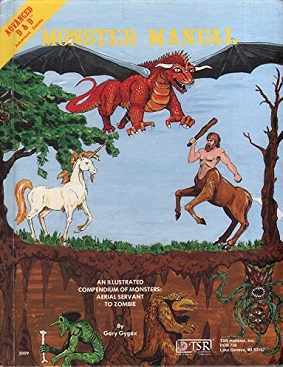
The Monster Manual is the primary bestiary sourcebook for monsters in the Dungeons & Dragons fantasy role-playing game, first published in 1977 by TSR. The Monster Manual was the first hardcover D&D book and includes monsters derived from mythology and folklore, as well as creatures created specifically for D&D. Creature descriptions include game-specific statistics, a brief description of its habits and habitats, and typically an image of the creature. Along with the Player's Handbook and Dungeon Master's Guide, the Monster Manual is one of the three "core rulebooks" in most editions of the D&D game. As such, new editions of the Monster Manual have been released for each edition of D&D. Due to the level of detail and illustration included in the 1977 release, the book was cited as a pivotal example of a new style of wargame books. Future editions would draw on various sources and act as a compendium of published monsters.

HeroQuest, is an adventure board game created by Milton Bradley in conjunction with the British company Games Workshop in 1989, and re-released in 2021. The game is loosely based around archetypes of fantasy role-playing games: the game itself was actually a game system, allowing the gamemaster to create dungeons of their own design using the provided game board, tiles, furnishings and figures. The game manual describes Morcar/Zargon as a former apprentice of Mentor, and the parchment text is read aloud from Mentor's perspective. Several expansions have been released, each adding new tiles, traps, artifacts, and monsters to the core system.

Dragon Strike is a 1993 adventure board game from TSR, Inc. based on the Dungeons & Dragons (D&D) fantasy role-playing game. It was intended to be a pathway for beginners to start with, and for players to eventually play the full Advanced Dungeons & Dragons tabletop game after kindling their interest.

Ravenloft is an adventure module for the Dungeons & Dragons (D&D) fantasy role-playing game. The American game publishing company TSR, Inc. released it as a standalone adventure booklet in 1983 for use with the first edition Advanced Dungeons & Dragons game. It was written by Tracy and Laura Hickman, and includes art by Clyde Caldwell with maps by David Sutherland III. The plot of Ravenloft focuses on the villain Strahd von Zarovich, a vampire who pines for his lost love. Various story elements, including Strahd's motivation and the locations of magical weapons, are randomly determined by drawing cards. The player characters attempt to defeat Strahd and, if successful, the adventure ends.
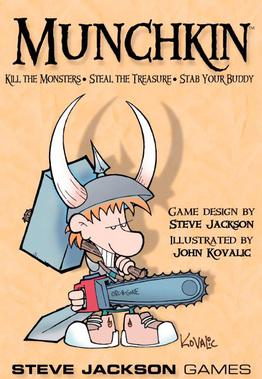
Munchkin is a dedicated deck card game by Steve Jackson Games, written by Steve Jackson and illustrated by John Kovalic. It is a humorous take on role-playing games, based on the concept of munchkins.

An owlbear is a fictional creature originally created for the Dungeons & Dragons fantasy role-playing game. An owlbear is depicted as a cross between a bear and an owl, which "hugs" like a bear and attacks with its beak. Inspired by a plastic toy made in Hong Kong, Gary Gygax created the owlbear and introduced the creature to the game in the 1975 Greyhawk supplement; the creature has since appeared in every subsequent edition of the game. Owlbears, or similar beasts, also appear in several other fantasy role-playing games, video games and other media.
Several different editions of the Dungeons & Dragons (D&D) fantasy role-playing game have been produced since 1974. The current publisher of D&D, Wizards of the Coast, produces new materials only for the most current edition of the game. However, many D&D fans continue to play older versions of the game and some third-party companies continue to publish materials compatible with these older editions.
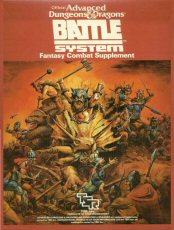
Battlesystem is a tabletop miniature wargame designed as a supplement for use with the Dungeons & Dragons role-playing game. The original Battlesystem was printed as a boxed set in 1985 for use with the first edition AD&D rules. For the second edition of AD&D, a new version of Battesystem was printed as a softcover book in 1989.
The Dungeons & Dragons Basic Game is an introductory version of Dungeons & Dragons (D&D) role-playing game packaged in the form of a board game. The original game was released in 2004 by Wizards of the Coast and was designed by Jonathan Tweet, one of the D&D 3rd edition designers. A new version of this game was released in September 2006.
The Ranger is one of the standard playable character classes in most editions of the Dungeons & Dragons fantasy role-playing game. Rangers are skilled bushcraftsmen/woodcraftsmen, and often lived reclusive lives as hermits.

Kobolds are a fictional race of humanoid creatures, featured in the Dungeons & Dragons roleplaying game and other fantasy media. They are generally depicted as small reptilian humanoids with long tails, distantly related to dragons.

Gods, Demi-Gods & Heroes is a supplementary rulebook for the Dungeons & Dragons (D&D) fantasy role-playing game. Its product designation is TSR 2006.

The original Dungeons & Dragons boxed set by Gary Gygax and Dave Arneson was published by TSR, Inc. in 1974. It included the original edition of the Dungeons & Dragons fantasy role-playing game. Its product designation was TSR 2002.
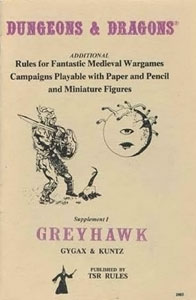
Greyhawk is a supplementary rulebook written by Gary Gygax and Robert J. Kuntz for the original edition of the Dungeons & Dragons (D&D) fantasy role-playing game. It has been called "the first and most important supplement" to the original D&D rules. Although the name of the book was taken from the home campaign supervised by Gygax and Kuntz based on Gygax's imagined Castle Greyhawk and the lands surrounding it, Greyhawk did not give any details of the castle or the campaign world; instead, it explained the rules that Gygax and Kuntz used in their home campaign, and introduced a number of character classes, spells, concepts and monsters used in all subsequent editions of D&D.

Blackmoor is a supplementary rulebook of the original edition of the Dungeons & Dragons fantasy role-playing game written by Dave Arneson.

The Dungeons & Dragons Basic Set is a set of rulebooks for the Dungeons & Dragons (D&D) fantasy role-playing game. First published in 1977, it saw a handful of revisions and reprintings. The first edition was written by J. Eric Holmes based on Gary Gygax and Dave Arneson's original work. Later editions were edited by Tom Moldvay, Frank Mentzer, Troy Denning, and Doug Stewart.
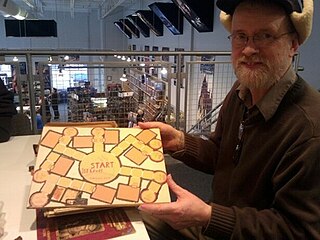
David R. Megarry is a game designer most notable for the board game Dungeon!.
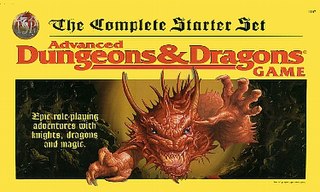
The Dungeons & Dragons Starter Set is a category of companion accessories across multiple editions of the Dungeons & Dragons fantasy role-playing game. In general, the Starter Set is a boxed set that includes a set of instructions for basic play, a low level adventure module, pre-generated characters, and other tools to help new players get started.
















